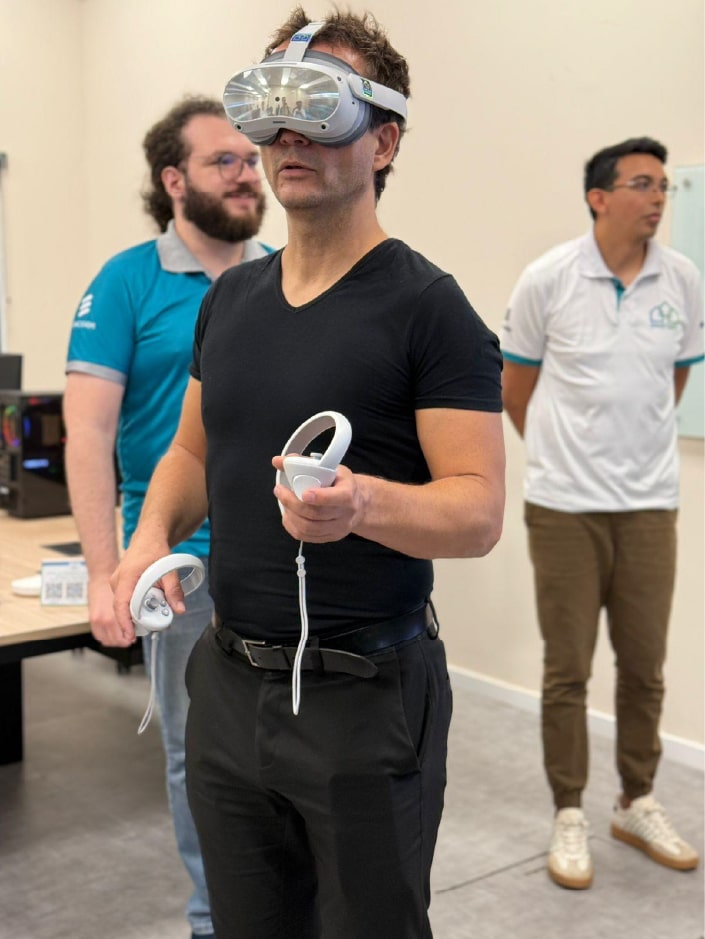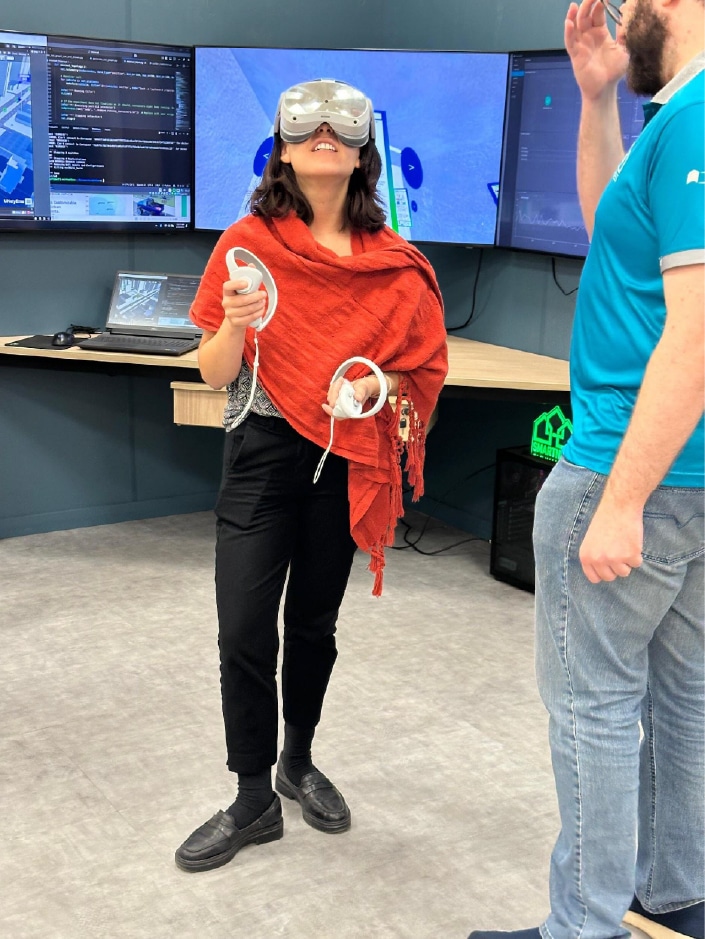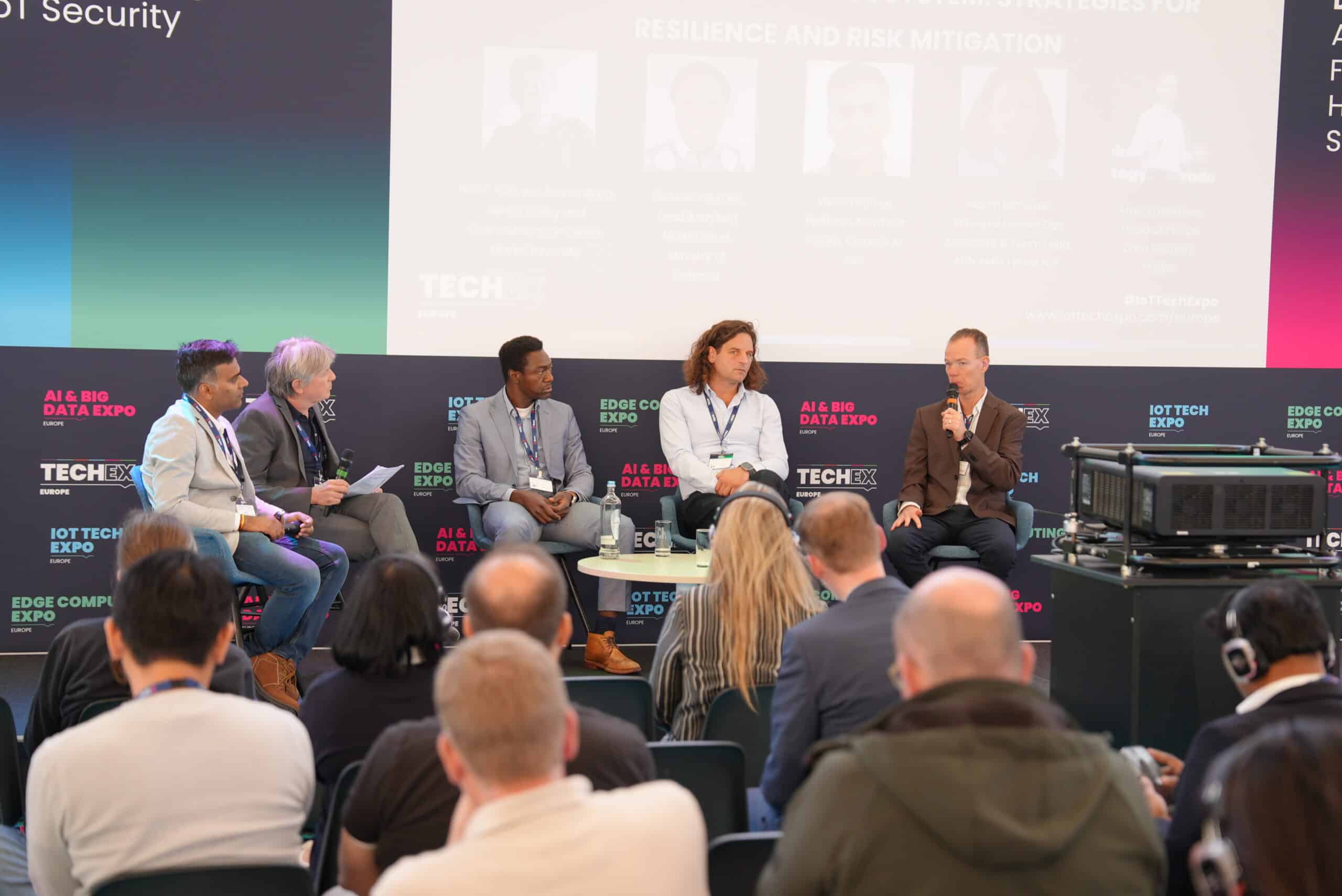
As part of a two-week mission to Brazil, a delegation from the European Telecommunications Standards Institute (ETSI), coordinator of the InDiCo-Global Project, participated in a study visit to Campinas. The city and its region, sometimes called the Brazilian Silicon Valley, are known for cutting-edge innovation and technological development, thanks to their university and research centres, which are looked to by global industry players and researchers.
The delegation, composed of Xavier Piednoir, Director of International Projects, and Mariana De Hoyos, Coordinator for International Projects, visited Campinas to build links with the research community in Brazil, given that their work will feed into the standardisation of future ICT technologies.
Two prominent research centres were visited: the Faculty of Electrical and Computer Engineering (FEEC – Faculdade de Engenharia Elétrica e de Computação) at the University of Campinas (UNICAMP) and the Centre for Research and Development (CPQD – Centro de Pesquisa e Desenvolvimento). The purpose of the visit was to learn from Brazil’s work in ICT and identify potential cooperation areas, building on contacts established during the previous InDiCo project, during which ETSI already collaborated with research centres in Brazil, notably CPQD. The new project, InDiCo-Global, seeks to amplify diverse voices in standardisation, notably new generations, enhance cooperation, and emphasise how coordination and participation in the standardisation process can lead to the effective development of future, human-centric technologies that deliver global interoperability.


Discovering the labs and the research at FEEC-UNICAMP
The session kicked off with a welcome address by Prof. Dr Hugo Figueroa, Director of FEEC. He highlighted the crucial interplay between research and standardisation and the importance of fostering international cooperation, emphasising the progress in both research and standardisation activities. He thanked ETSI for the visit and their interest.
Following the presentation, Prof. Dr Christian Rothenberg, Director of SMARTNESS 2030, presented the SMARTNESS 2030 5G/6G Research Project, an initiative jointly funded by the São Paulo Research Foundation (FAPESP – Fundação de Amparo à Pesquisa do Estado de São Paulo) and Ericsson.
The project, in collaboration with UNICAMP, the University of São Paulo (USP), and the Federal University of São Carlos (UFSCAR), is focused on the engineering of cloud computing and network infrastructures, that is, their design and operation. The aim is to build capabilities that empower next-generation internet services and applications, leveraging current and upcoming 5G/6G communication networks. These infrastructures are being created within an open-source framework that supports open research, standardisation, training, and education. The goal is to develop talent and produce scientific publications that could lead to industry-leading initiatives, including the launch of startups.
Prof. Dr. Christian Rothenberg emphasised the importance of standardisation, highlighting the need for researchers to actively engage in standardisation processes. The team presented their research efforts, focusing on distributed computer networking, with an emphasis on the development of adaptive and secure network applications suitable for industrial environments. Additionally, they presented advancements in distributed edge computing swarm technology and the design of cognitive closed-loop control systems for Edge Internet of Vehicles (IoV) services. The team also noted their active work on enhancing industrial automation within edge network infrastructures.
After the presentation, Xavier Piednoir provided an overview of ongoing work at ETSI. He explained that, as a Standards Development Organisation (SDO) formally recognised as a European Standardisation Organisation (ESO), alongside CEN and CENELEC, ETSI serves as an industry-led platform for developing a wide range of standards for digital technologies relevant not only for Europe but also globally.
The presentation highlighted how, since its foundation in 1988, ETSI has played a significant role in advancing generations of mobile cellular network technology, uniting industry leaders and SDOs from around the globe. This collaboration led to ETSI becoming a founding partner of the international Third Generation Partnership Project (3GPP), which is at the forefront of developing the current 5G and future 6G networks.
ETSI emphasised that its standardisation process is open, inclusive, and transparent, allowing contributions from industry, research centres, and other interested stakeholders. This process is designed to ensure the interoperability of systems while maintaining an Intellectual Property Rights (IPR) policy that balances the rights of IPR holders with the need for access to technology.
Discussions highlighted common interests in 5G/6G and related work conducted in ETSI Industry Specification Groups (ISGs) and Software Development Groups (SDGs), AI, post-quantum cryptography, and education on standardisation.
Later, members of FEEC gathered at the amphitheatre for a lecture by Mischa Dohler, a noted researcher in 5G/6G, augmented reality (AR), and generative AI. Titled “The Dawn of an Immersive Internet: AR, AI & API on the Road to 6G,” the lecture showcased Dohler’s work as the VP of Emerging Technologies at Ericsson. He discussed various consumer-oriented and industry-driven initiatives aimed at advancing new AR, AI, and APIs.
While discussing three main aspects of technology disruption, he emphasised that as more AR and AI technologies are implemented, the number of available use cases increases. He described how, in the near future, headsets could assist in situations where self-driving cars cannot resolve complex scenarios, with a human operator taking temporary control. He also highlighted the crucial links across networks to ensure reliable connectivity from headset to vehicle, the need for devices that are comfortable for users, and applications that improve the user interface, stressing the need for coordination across all layers. This includes the standardisation necessary to align performance with the requirements of future networks, while ensuring seamless integration of 4G and 5G systems with the upcoming 6G networks, including potential shifts in downlink and uplink data transmission needs. He noted how AR use cases, particularly those relying on sensing the environment around the user, are key drivers for faster uplink, challenging models that have traditionally prioritised downlink performance.
After an insightful debate on the future of networks and consumer adoption of technologies, faculty members showcased the LEMAC (Laboratory of Applied and Computational Electromagnetics) and SMARTNESS labs. Attendees had the opportunity to try VR headsets and experience use cases showcasing advancements in AR technology. The launch of the SMARTNESS Studio 5G (SS5G) private 5G network was also announced, fully powered and ready for hands-on exploration by researchers.
“The visit and learning from both ETSI and Mischa Dohler’s research have been truly disruptive, exploring the frontiers of 6G and AI. It is imperative to emphasise ETSI’s critical role in defining standards for future technological generations.” — Alcides Thomas, PhD student at FEEC, UNICAMP.

R&D at CPQD brings Brazil to the forefront of technology and innovation
CPQD was established in 1976 as a telecommunications research and development centre for Telebras. Following privatisation, it became an independent foundation. Its main work places a strong emphasis on innovation in ICT, focusing on the digital transformation process, enhancing user experience, reinventing business models, ensuring security and compliance, and fostering the creation of new ICT products. To this day, CPQD remains among the largest research centres in Brazil, if not the largest.
The visit began with a presentation on CPQD’s areas of research and development, including technological focus areas such as the Internet of Things (IoT), artificial intelligence (AI), connectivity, blockchain, and sustainable technologies related to the energy sector.
This presentation showcased a variety of use cases tailored to Brazil’s unique needs. CPQD leads research and development activities in the digital transformation of businesses, with innovation projects and tax incentives for project development; the development of startups and new innovative companies; the development of networks related to telecommunications; and it serves as a laboratory for certification and testing.
One remarkable use case, particularly in Brazil, is the use of blockchain in agriculture to track carbon credits for fair trade cacao or to track cattle across the supply chain.
After a fruitful discussion identifying multiple areas of synergy between ETSI, the InDiCo-Global project, and the expertise of CPQD, the hosts gave a tour of different labs and sectors. The delegation first visited Techoa, a newly inaugurated incubator for startups focused on innovation in digital technologies and sustainability. Later, they presented the different labs working on the Open RAN project with their IoT, AR/VR, and drone applications. The team then explored CPQD’s focus on energy technologies, including projects on charging stations, vertical landing, and collaboration with the Brazilian aerospace industry on airplanes.
“The visit to Campinas was a way to gain key insights into ICT development and research in Brazil, where it was possible to see the avenues for cooperation and exchange on key aspects of technology development.” — Mariana De Hoyos, International Projects Coordinator at ETSI.
In conclusion, the intersection between the work on digital within the ESOs and the vibrant research and innovation landscape in Brazil kindles a vision of what is possible when collaboration thrives. The key takeaway is the importance of synergy between research institutes and SDOs. Together, technology applications can deliver on their promises.
Lessons from a fast-evolving region
Brazil stands as a key player in the region, with leadership in research and a unique case leading the Americas towards the realisation of 6G and the integration of AI, IoT, and energy technologies. To truly unlock the potential of these advancements, it is essential to ensure that new standards capture the results of cutting-edge R&I in all regions of the world and engage researchers and young professionals in the standardisation process. These collaborative efforts can deliver interoperability across various network layers and regions and pave the way for a more inclusive digital future.
The lessons learned during the visit have been immensely valuable, fostering a spirit of cooperation. Initiatives like the InDiCo-Global project show the benefit of building connections across policy, regulatory, and standardisation frameworks for technologies. The remarkable research from the FEEC-UNICAMP SMARTNESS project and CPQD demonstrates that the next generation of technology is not just on the horizon; it is being actively developed by passionate innovators dedicated to delivering on the promises of the future.
By fostering coordination and collaboration among standardisation bodies, research communities, industry, and civil society, we can realise the potential of interoperability. This collective effort not only aims to enhance digital inclusion worldwide but also paves the way for a more human-centred approach.





